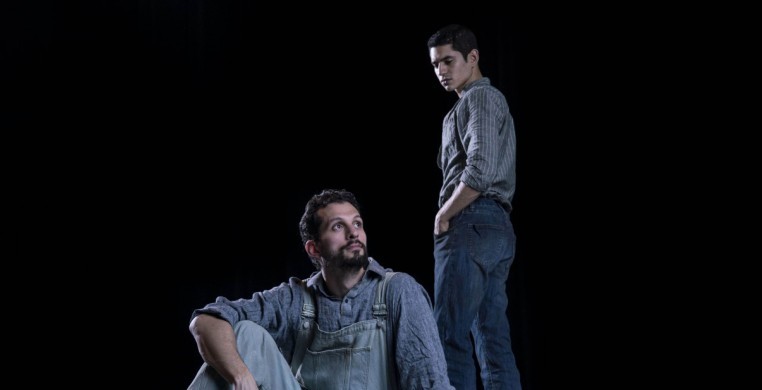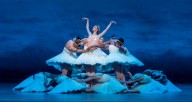When asked what drew her to John Steinbeck’s 1937 novella, “Of Mice and Men,” British choreographer Cathy Marston said, “It asks all the questions that invigorate me—faith in friendship, why people are so isolated…”
See Chicago Dance reached Marston by phone during a break in rehearsals at Joffrey Tower where she is putting the finishing touches on the world premiere production, opening April 27th at the Lyric Opera House. (See below for details.)
Marston’s first encounter with “Of Mice and Men” was as a school girl in Great Britain. She has continued to return to its compelling themes throughout her life. In a conversation about the possibility for future artistic collaboration with fellow Brit and friend Ashley Wheater back in 2019, he said he’d always thought “Of Mice and Men” would be great material for adaptation to dance, especially for The Joffrey Ballet dance artists, whose interpretive range is well-suited to the demands of dramatic theater.
“The climax, how the friendship plays out, is both heartbreaking and heartwarming,” Marston said. The complexity of Lenny and George’s relationship juxtaposes devotion, redemption, love, guilt, and mercy in a world that drives them toward the story’s tragic end.
Marston had her work cut out for her, with collaboration at the heart of her process. First, she worked with long-time colleague and dramaturg Edward Kemp to develop a written scenario. Once the story was intact, production concepts and refinement continued with composer Thomas Newman, scenic designer Lorenzo Savoini and costume designer Bregjie van Balen.
Marston’s process for adaptation of written text to physical realization in movement and dance revolved around words. After further research, her objective became to develop a physical language for each character. She first generated a list of words from the text for each character that activated their physicality, psychological intentions, psychological and physical gestures, their physical center and how each relates to the people they encounter and the spaces they enter and inhabit.
Finally, just when she was ready to meet with the dancers, COVID intervened, shut down prospects for in-person rehearsals, and delayed the anticipated premiere date indefinitely. Marston pivoted to Zoom sessions. She began with an introductory presentation to the entire cast before beginning to work with each character separately via Zoom.
At the time, she wasn’t hopeful for the effectiveness of virtual rehearsals. The biggest challenge was trying to achieve a cohesive narrative with the limitations virtual rehearsals imposed on the process. Another big question for Marston was whether she would be able to achieve a successful physical translation from text to movement for each character.
The biggest surprise for Marston was how fruitful the Zoom process was ultimately. “We were able to develop a whole movement vocabulary for each character,” she said, which saved a lot of time once they were able to start limited in-person rehearsals in the studio.
In a recent phone conversation with SCD, Xavier Núñez, who plays George, recalled the Zoom process as being extremely helpful. “She pulled a lot about my character from the novel, words like ‘cutting,’ ‘stern,’ ‘sharp,’ and ‘reserved.’” On Zoom they experimented together, translating those words into movement. Marston asked Núñez to notice how the other character in a scene may be feeling, and to respond to that. They explored ways that George could comfort Lenny, and what he would do when he became frustrated. “It was difficult not to get angry at Lenny,” Núñez said, “and as George, I would get frustrated when things would go wrong.” His psychological gesture became tapping his foot. He and Marston developed a way for George to walk, slumped over, to keep a low profile. “George is tired, working class,” Núñez said. He found he had to “get more pedestrian” in his posture and walking. “Redeeming” was a key operative word for George. “He cares about Lenny, and never gives up on him.”
Another operative word that served to characterize George and Lenny’s relationship was “reserved.” Lenny had affection for soft things, and when he rips off a piece of a woman’s dress, George and Lenny had to flee a lynch mob coming after them, so staying out of sight was of paramount importance for their survival.
“This is the first time I am helping to create a character that’s made on me,” Núñez said. Of Marston’s collaborative process, he added, “It’s a big responsibility, and it’s beautiful being asked to exercise artistic freedom.” Rehearsing with composer Thomas Newman’s score, Núñez said, “He created it watching us dancing. The music guides my (dramatic) intention.”
Dylan Gutierrez, who plays Lenny, added the word “lumbering” to Marston’s list, putting a positive spin on Lenny’s slow, clumsy gait with his amazing strength to wield huge props and scenic pieces made of lumber.
Another big challenge for Marston was how to conceptualize the dream in movement. Finding a way to describe the dream physically—the patch of land, the stream, the rabbits—Marston has George transforming different props in a childlike pageant for Lenny. “This doesn’t look like a classical ballet,” Marston added.
Savoini’s set is an endless horizontal line, with one vertical interruption, made of barn board. Eight wooden benches delineate the space for each scene, with the dancers reconfiguring them as interior walls of rooms, whole buildings, horses, or farm implements.
The score for “Of Mice and Men” is Tony-award-winning composer Thomas Newman’s first dance score. “Cathy reached out to Tom for what she needed,” said Joffrey rehearsal director Adam Blyde in a recent phone interview with SeeChicagoDance. As the piece was changing, the score would be changing as well. Dramatic intention and movement were the essential guide. The company has been rehearsing with a fully-recorded, electronic version of the orchestral score, but conductor Scott Speck will lead the Lyric Opera Orchestra in the live performance.
“It’s been an absolute pleasure,” Blyde said, “a new experience. The way Cathy works is very collaborative. She wants everybody to be involved to get to the heart of the story and what these characters think and feel.” “It was most exciting to be involved in the process from day one. You really feel you have a voice!”
Marston’s process adapting “Of Mice and Men” to dance has brought a whole new perspective to The Joffrey Ballet’s creation of a new work. Her delight in play and the resources of her collaborators generate universal enthusiasm among the dancers and production staff. Working together and overcoming daunting obstacles to bring new resonance to one of literature’s iconic tales of the human condition has been a uniquely inspiring experience for The Joffrey Ballet. I’m betting it will be for its audiences as well!
--
The Joffrey Ballet presents Serenade & Of Mice and Men April 27-May 8 at the Lyric Opera House, 20 N. Wacker Drive. Tickets start at $35 and are available by clicking the event page below.


